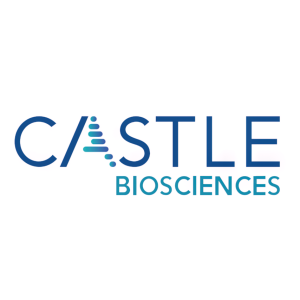Castle’s Poster on DecisionDx®-SCC Selected as a “Late Breakers” Top Five Finalist for the Akamai Award, Recognizing the Best Posters at Maui Derm Hawaii 2025
Highlights from Castle’s DecisionDx-SCC poster will be shared in a special podium presentation during the Late Breakers 2025 session on Tuesday, Jan. 21, from 10:45-11:15 a.m. local time
The Company’s poster on DecisionDx-SCC, which was selected as a “Late Breakers” top five finalist for the best poster Akamai Award, shares new data from a study involving Castle’s largest cohort of patients with cutaneous squamous cell carcinoma (SCC) to date (n=1,408). This study demonstrates improved risk stratification of patients with SCC tumors located on the head or neck when the test’s results are combined with Brigham and Women’s Hospital (BWH) staging.
“Patients with SCC tumors of the head or neck may be at increased risk of metastasis and thus could be candidates for adjuvant treatments, such as radiation, to reduce this risk,” said Dr. Emily Ruiz, M.D., MPH, FAAD, board-certified dermatologist and Mohs micrographic surgeon at Brigham and Women’s Hospital in
Castle’s posters at Maui Derm Hawaii, detailed below, will be available for viewing electronically on the conference app. Additionally, as a “Late Breaker” Five finalist, Castle’s DecisionDx-SCC poster will also be highlighted in a special podium presentation on Tuesday, Jan. 21, from 10:45-11:15 a.m. local time.
DecisionDx-SCC
- Title: Metastasis-free survival prediction with the 40-gene expression profile (40-GEP) test in patients with cutaneous squamous cell carcinoma of the head and neck (HNcSCC) risk stratified according to the Brigham and Women’s Hospital (BWH) tumor staging criteria
-
Lead author: Emily S. Ruiz, M.D., MPH, Brigham and Women’s Hospital and Harvard Medical School,
Boston -
Key take-aways:
Using the largest combined patient cohort to date, this study assessed the ability of the DecisionDx-SCC test to stratify patients with HNcSCC according to their risk of metastasis and the prognostic value added to BWH staging through use of the test’s results. The study data demonstrated that DecisionDx-SCC was a significant predictor of metastasis, with distinct three-year metastasis-free survival rates provided across its risk classes: Class 1 (92.3% ), Class 2A (81.3% ), and Class 2B (57.8% ). Further, combining DecisionDx-SCC test results with BWH staging significantly improved the accuracy of metastatic risk prediction (ANOVA p-value <0.001), which can help clinicians and patients make more informed and risk-aligned management decisions.
DecisionDx-Melanoma
- Title: Clinical use of the i31-GEP for SLNB for T1-T2a cutaneous melanoma significantly and safely reduces unnecessary procedures
-
Lead Author: Timothy Beard, M.D., Summit Medical Group,
Bend, Oregon -
Key take-aways:
The study included 471 patients whose decision to pursue or forgo sentinel lymph node biopsy (SLNB) surgery was informed by DecisionDx-Melanoma test results. The study showed that integrating DecisionDx-Melanoma test results into SLNB decisions resulted in25% fewer SLNBs performed compared to a matched patient cohort (p<0.001). No patients with a DecisionDx-Melanoma-predicted risk of sentinel lymph node (SLN) positivity of less than5% who decided to have an SLNB had a positive SLN (0/58 patients). These study results support the use of DecisionDx-Melanoma to guide important SLNB decisions and provide further evidence that the test can safely reduce the number of SLNBs performed in patients with a low risk of SLN metastasis.
MyPath Melanoma
- Title: Diagnostic discordance among histopathological reviewers for difficult-to-diagnose melanocytic lesions
-
Key take-aways:
In a large cohort of patients with suspicious lesions (n=3,317), approximately24% had differing diagnoses by the nine board-certified dermatopathologists who reviewed samples in the study, indicating that these lesions had ambiguous features and were difficult to diagnose. These findings support the need for an objective diagnostic tool like MyPath Melanoma to aid in providing an accurate diagnosis for ambiguous melanocytic lesions in the context of other clinical and histopathological findings.
About DecisionDx-SCC
DecisionDx-SCC is a 40-gene expression profile test that uses an individual patient’s tumor biology to stratify risk of metastasis in patients with cutaneous squamous cell carcinoma who have one or more NCCN high-risk factors. The test result, in which patients are stratified into a Class 1 (low), Class 2A (higher) or Class 2B (highest) risk category, predicts individual metastatic risk to inform risk-appropriate management and guide decision-making regarding the use of adjuvant radiation therapy. Peer-reviewed publications have demonstrated that DecisionDx-SCC is an independent predictor of metastatic risk and that the test can significantly improve risk-stratification when used with traditional staging systems and clinicopathologic risk factors to guide risk-aligned management and treatment decisions. Learn more at www.CastleBiosciences.com.
About DecisionDx-Melanoma
DecisionDx-Melanoma is a gene expression profile risk stratification test. It is designed to inform two clinical questions in the management of cutaneous melanoma: a patient’s individual risk of sentinel lymph node positivity and a patient's personal risk of melanoma recurrence and/or metastasis. By integrating tumor biology with clinical and pathologic factors using a validated proprietary algorithm, DecisionDx-Melanoma is designed to provide a comprehensive and clinically actionable result to guide risk-aligned patient care. DecisionDx-Melanoma has been shown to be associated with improved patient survival and has been studied in more than 10,000 patient samples. DecisionDx-Melanoma’s clinical value is supported by more than 50 peer-reviewed and published studies, providing confidence in disease management plans that incorporate the test’s results. Through Sept. 30, 2024, DecisionDx-Melanoma has been ordered approximately 183,000 times for patients diagnosed with cutaneous melanoma. Learn more at www.CastleBiosciences.com.
About MyPath Melanoma
MyPath Melanoma is Castle’s gene expression profile test designed to provide an accurate, objective result to aid dermatopathologists and dermatologists in characterizing difficult-to-diagnose melanocytic lesions. Of the approximately two million suspicious pigmented lesions biopsied annually in the
About Castle Biosciences
Castle Biosciences (Nasdaq: CSTL) is a leading diagnostics company improving health through innovative tests that guide patient care. The Company aims to transform disease management by keeping people first: patients, clinicians, employees and investors.
Castle’s current portfolio consists of tests for skin cancers, Barrett’s esophagus, mental health conditions and uveal melanoma. Additionally, the Company has active research and development programs for tests in these and other diseases with high clinical need, including its test in development to help guide systemic therapy selection for patients with moderate-to-severe atopic dermatitis seeking biologic treatment. To learn more, please visit www.CastleBiosciences.com and connect with us on LinkedIn, Facebook, X and Instagram.
DecisionDx-Melanoma, DecisionDx-CMSeq, i31-SLNB, i31-ROR, DecisionDx-SCC, MyPath Melanoma, DiffDx-Melanoma, TissueCypher, IDgenetix, DecisionDx-UM, DecisionDx-PRAME and DecisionDx-UMSeq are trademarks of Castle Biosciences, Inc.
Forward-Looking Statements
This press release contains forward-looking statements within the meaning of Section 27A of the Securities Act of 1933, as amended, and Section 21E of the Securities Exchange Act of 1934, as amended, which are subject to the “safe harbor” created by those sections. These forward-looking statements include, but are not limited to, statements concerning: the ability of DecisionDx-SCC to improve risk stratification of patients with SCC tumors located on the head or neck when combined with BWH staging; the ability of DecisionDx-Melanoma to guide important SLNB decisions and safely reduce the number of SLNBs performed in patients with a low risk of SLN metastasis; and the ability of MyPath Melanoma to aid in providing an accurate diagnosis for ambiguous melanocytic lesions in the context of other clinical and histopathological findings. The words “believe,” “can,” “could,” “potential” and similar expressions are intended to identify forward-looking statements, although not all forward-looking statements contain these identifying words. We may not actually achieve the plans, intentions or expectations disclosed in our forward-looking statements, and you should not place undue reliance on our forward-looking statements. Actual results or events could differ materially from the plans, intentions and expectations disclosed in the forward-looking statements that we make. These forward-looking statements involve risks and uncertainties that could cause our actual results to differ materially from those in the forward-looking statements, including, without limitation: subsequent study or trial results and findings may contradict earlier study or trial results and findings or may not support the results obtained in these studies, including with respect to the discussion of our tests in this press release; actual application of our tests may not provide the aforementioned benefits to patients; and the risks set forth under the heading “Risk Factors” in our Annual Report on Form 10-K for the year ended December 31, 2023, our Quarterly Report on Form 10-Q for the quarter ended September 30, 2024 and in our other filings with the SEC. The forward-looking statements are applicable only as of the date on which they are made, and we do not assume any obligation to update any forward-looking statements, except as may be required by law.
View source version on businesswire.com: https://www.businesswire.com/news/home/20250117705622/en/
Investor Contact:
Camilla Zuckero
czuckero@castlebiosciences.com
Media Contact:
amarshall@castlebiosciences.com
Source: Castle Biosciences Inc.









